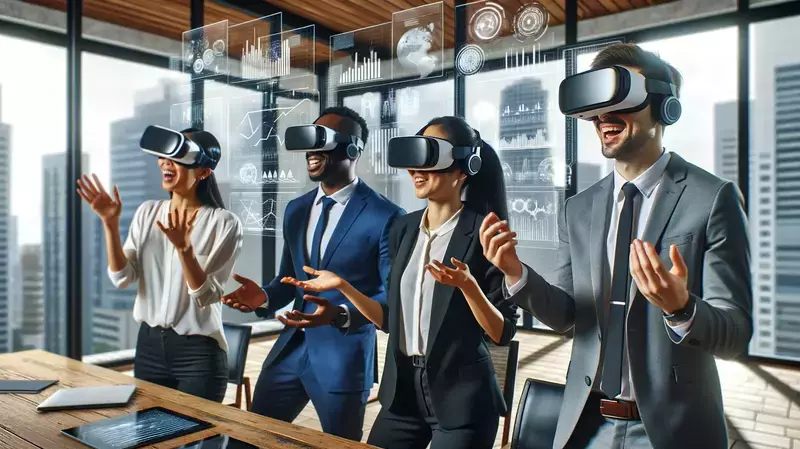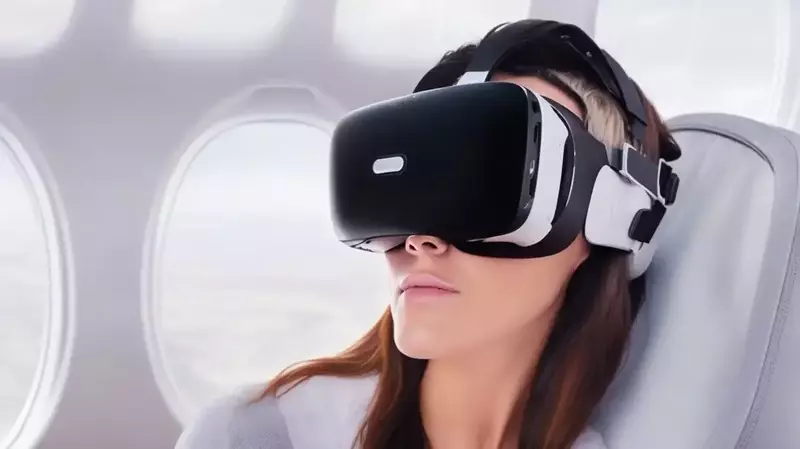Can you have business meetings in virtual reality? As technology advances, remote collaboration and communication become increasingly feasible, including the use of virtual reality for business meetings which can provide a more immersive experience than traditional video conferencing. One such development is the use of virtual reality (VR) for conducting business meetings, offering a new level of immersion and interaction that traditional video conferencing simply cannot match.
In this blog post, we will delve into the world of virtual reality and explore how it can be utilized for effective business meetings. We will discuss the benefits and challenges associated with VR business meetings, as well as provide guidance on preparing for these unique encounters.
As you read on, you’ll discover best practices to ensure your team’s success when navigating this exciting frontier in modern workplace communication. Can you have business meetings in virtual reality? Let us help you find out!
Table of Contents
What is Virtual Reality?
VR is a doorway to an alternate reality, created digitally and experienced through specialised headsets with controllers. With a VR headset and controllers, you can interact with this world as if you were really there. Today’s advanced VR systems such as Oculus Rift and HTC Vive offer a heightened level of immersion, with realistic visuals, surround sound, and haptic feedback.
Types of Virtual Reality
- Fully Immersive: These systems provide a complete sensory experience with high-resolution visuals, surround sound, and haptic feedback through wearable devices like gloves or bodysuits.
- Semi-Immersive: These setups offer some level of immersion through visual displays or auditory cues, but typically don’t include tactile sensations.
- Non-Immersive: This is experienced on traditional computer screens without any additional hardware required for full immersion.
Recently, VR has become a popular tool for professional applications such as holding digital meetings in virtual worlds. Companies like Spatial, MeetinVR, and VirBELA have developed platforms specifically designed for hosting virtual business meetings. These solutions offer customizable avatars, interactive whiteboards, and file-sharing capabilities to facilitate seamless collaboration between team members.
The Future of VR in Business
As VR technology becomes more accessible, we’ll likely see more businesses adopting it for meetings and other collaborative activities. This shift could lead to reduced travel costs, increased productivity, and improved employee engagement through unique team-building exercises within immersive environments.
Virtual reality is an exciting technology with immense potential across various industries, including business communication. As more organizations explore its benefits, we’ll undoubtedly see new developments emerging on how to best utilize these digital spaces effectively within professional settings.
“Experience the future of business meetings with virtual reality. Collaborate seamlessly and reduce travel costs with customizable avatars and interactive whiteboards. #VRinBusiness #FutureOfWork”Click to Tweet
Benefits of Business Meetings in VR
Virtual reality (VR) business meetings offer a range of advantages that can enhance the overall experience and efficiency for participants. From cost savings to increased engagement, let’s explore some key benefits of hosting your next meeting within a virtual environment.
Saving Time and Money on Travel
One major advantage of using VR for business meetings is the potential to save time and money on travel expenses. With people being able to participate from any area on the planet, there is no need for pricey trips or lodging. The utilization of VR for business meetings has the potential to decrease costs and lessen the environmental effects brought about by physical gatherings.
Better Collaboration and Engagement
Virtual reality technology enables more immersive experiences than standard video conferencing platforms, leading to improved collaboration among team members. In a VR meeting, attendees can interact with each other through avatars, share 3D models or presentations, and even engage in team-building activities designed specifically for this unique environment.
Inclusive Environment for Remote Workers
A significant challenge faced by remote teams is ensuring everyone feels included during meetings. Virtual reality provides an opportunity to create an inclusive space where all attendees feel present regardless of their physical location. By simulating real-life interactions such as hand gestures or eye contact, VR helps bridge the gap between remote workers and those located at company headquarters.
Easier Access to Global Talent Pool
- By eliminating geographical barriers, virtual reality meetings allow businesses to tap into a global talent pool. This can lead to more diverse and creative ideas being shared during brainstorming sessions or problem-solving discussions.
Customizable Meeting Spaces
With VR meetings, companies have the capability to customize their environment according to their desired objectives and outcomes. Whether it’s creating a professional conference room or an informal lounge area for casual discussions, the possibilities are endless. This flexibility allows companies to tailor their meeting spaces based on specific objectives and desired outcomes.
Increased Security and Privacy
Virtual reality platforms often provide enhanced security features compared to traditional video conferencing tools. With end-to-end encryption and strict access controls in place, businesses can ensure that sensitive information remains confidential during virtual meetings.
Leverage the advantages of virtual reality platforms to optimize your business meetings for efficacy, interactivity, and cost-effectiveness while offering unparalleled chances for teamwork in a cutting-edge digital environment.
Key Takeaway:
Virtual reality (VR) business meetings can save time and money on travel, enhance collaboration and engagement among team members, create an inclusive environment for remote workers, tap into a global talent pool, provide customizable meeting spaces and increased security features. By taking advantage of these benefits businesses can make their meetings more efficient while providing unique opportunities for collaboration within a cutting-edge digital landscape.
Challenges of Business Meetings in VR
VR has its advantages for corporate gatherings, yet it doesn’t come without difficulties. Here are some common issues:
Technical Difficulties
Connection problems, software glitches, and hardware malfunctions can disrupt communication and collaboration in VR meetings.
Accessibility and Compatibility Issues
Not everyone has access to compatible devices like headsets and controllers, limiting participation. Compatibility issues between different platforms can also pose challenges.
User Comfort Levels with Technology
Some users might feel uncomfortable navigating virtual environments or struggle with motion sickness induced by prolonged headset use.
Maintaining Professionalism
- In an immersive virtual environment, distractions abound, making it challenging to maintain focus on the agenda at hand.
Security and Privacy Concerns
Security and privacy are paramount concerns when conducting business meetings in VR. Robust encryption protocols, secure communication channels, and strict access controls are necessary to ensure sensitive information remains confidential. Sharing personal data like biometric information within a virtual environment can also make some users uneasy.
Data Storage
- Storing meeting recordings or transcripts on third-party servers could raise potential security risks if not properly managed.
“Virtual reality has its perks for business meetings, but technical difficulties, accessibility issues and privacy concerns can pose challenges. #VRMeetings #BusinessTech”Click to Tweet
How to Prepare for a Business Meeting in VR

Preparing for a business meeting in virtual reality (VR) requires some additional steps compared to traditional meetings. However, with the right tools and approach, you can ensure that your VR meeting runs smoothly and effectively. Here are some tips on how to get ready for a successful meeting in virtual reality:
Choose the Right Platform
Selecting an appropriate VR conferencing platform is crucial as it determines the overall experience of your participants. Consider factors such as ease of use, compatibility with various devices, and available features when making your choice.
Test Your Equipment
Prior to the meeting, make sure all necessary equipment is functioning properly by testing it thoroughly. This includes checking audio quality through headphones or speakers and ensuring that headsets or other input devices are charged and connected correctly.
Set Up Your Virtual Environment
- Create an inviting space: Design your virtual environment so that it’s visually appealing while still maintaining professionalism.
- Add interactivity: Incorporate interactive elements like whiteboards or presentation screens into your environment to facilitate collaboration during discussions.
- Familiarize yourself with controls: Learn how to navigate within the environment using gestures or controllers before hosting a live session.
Send Out Invitations With Clear Instructions
In addition to providing standard information like date, time, and agenda items; include detailed instructions on accessing the VR platform along with any necessary hardware or software requirements. Provide an alternative to joining the meeting, such as video conferencing, for those who may not have access to VR equipment.
Plan Your Agenda and Presentation Materials
Just like in traditional meetings, having a well-structured agenda is essential for keeping discussions on track. Prepare your presentation materials ahead of time and ensure they are compatible with the chosen platform. This might involve converting files into specific formats or uploading them directly into the virtual environment.
Conduct a Dry Run
To avoid technical hiccups during the actual meeting, consider conducting a dry run with colleagues or team members beforehand. Attempting a dry run beforehand can help detect any potential problems and allow for necessary changes to be made.
Set Ground Rules for Participants
Establishing clear guidelines on etiquette can help maintain order during your VR business meeting:
- Mute microphones when not speaking: Encourage participants to mute their mics while others are talking to minimize background noise.
- Use non-verbal cues: Teach attendees how to use gestures or emojis within the platform as alternatives to verbal communication when appropriate.
By following these steps, you’ll be well-prepared for hosting successful business meetings in virtual reality environments that engage and inspire your participants.
Key Takeaway:
Preparing for a business meeting in virtual reality requires selecting the right platform, testing equipment, setting up an inviting and interactive environment, sending clear invitations with instructions, planning agendas and presentation materials ahead of time, conducting dry runs to identify potential issues beforehand and establishing ground rules for participants. By following these steps you can ensure that your VR meetings run smoothly and effectively.
Best Practices for Business Meetings in VR
VR provides a distinctive and captivating way to host business gatherings, but it is essential to adhere to best practices in order for the gathering to go off without a hitch. Here are some tips on how to make the most of your virtual reality office:
Choose the Right Platform
Selecting a suitable virtual meeting room is crucial for success. Consider factors such as ease of use, compatibility with various VR headsets, collaboration tools available, and whether it supports natural human interactions. Some popular platforms include Horizon Workrooms, Google Meet, and VR Meetings.
Create an Engaging Environment
Design or select a visually engaging virtual space that promotes creativity and interaction among participants. Many platforms offer customizable environments or templates tailored for specific industries or purposes. Incorporating elements like virtual tours or augmented reality (AR) can also enhance the immersive experience.
Prioritize Accessibility
Ensure all attendees have access to the necessary hardware (e.g., Oculus Rift or Quest 2) and software required for participation in the meeting. Provide clear instructions on setting up their devices beforehand if needed. Additionally, consider any accessibility needs of participants, such as closed captioning or audio descriptions.
Incorporate Interactive Elements
Make use of features like screen sharing, virtual whiteboards, polls, quizzes, and breakout sessions during discussions – these can help keep everyone engaged while simulating live experiences similar to real-life meetings. Utilizing collaboration tools like Miro or real-time collaboration can also enhance productivity.
Maintain Focus on Objectives
To avoid distractions caused by the immersive nature of VR technology, always remind participants about the goals at hand. Establish ground rules regarding etiquette, especially when interacting within shared spaces. Encourage active participation by inviting questions, comments, and feedback from all attendees. Utilize team-building activities or icebreakers to foster camaraderie among remote workers.
Monitor Time Effectively
Virtual reality meetings can sometimes feel longer than traditional ones due to their immersive nature. Keep track of time spent on each agenda item, and ensure breaks are scheduled when necessary. Utilizing tools like timers or setting reminders can help keep everyone on track.
Follow Up with Action Items
After the meeting, distribute a summary of key points discussed along with any assigned tasks for completion. This helps maintain momentum and ensures everyone is aligned moving forward. Utilizing tools like Notion or Trello can also help with task management.
By adhering to these best practices, you’ll be able to harness the power of VR technology for more productive, engaging, and efficient business meetings. As VR continues to evolve as an essential tool in modern workplace settings – particularly for distributed teams – staying informed about advancements in immersive technologies will help your organization remain at the forefront of innovation.
Key Takeaway:
Virtual reality can be used for business meetings, but it’s important to follow best practices. This includes choosing the right platform, creating an engaging environment, prioritizing accessibility, incorporating interactive elements, maintaining focus on objectives and monitoring time effectively. Following these guidelines will help ensure productive and efficient virtual meetings that harness the power of VR technology.
FAQs in Relation to Can You Have Business Meetings in Virtual Reality?
Can You Conduct Business Meetings in Virtual Reality?
Yes, virtual reality (VR) technology offers immersive and interactive meeting experiences for businesses, with platforms like Horizon Workrooms and Rumii providing virtual meeting spaces for remote teams to collaborate effectively using VR headsets.
How Can Virtual Reality Benefit Businesses?
Virtual reality can be used for training, product design, marketing, customer engagement, and collaboration, with companies utilizing platforms like VIVE Sync, LearnBrite, or custom-built solutions to enhance their business processes.
What Are the Key Benefits of Virtual Reality Meetings?
- Natural human interactions for better communication
- Immersive experiences for innovative team-building activities
- Shared environments for easier visualization of complex ideas
- Reduced travel requirements for saving time and resources
How Do You Host a VR Meeting?
To host a VR meeting, choose a suitable platform such as Horizon Workrooms or Rumii, ensure all participants have compatible VR hardware (headsets), create an account on the chosen platform, schedule the meeting with relevant details including date/time/invitees/link/access code/passwords if necessary, and then share the information with attendees.
Conclusion
Why settle for boring business meetings when you can have them in virtual reality?
Virtual reality is the future of business meetings, offering cost savings, increased productivity, and flexibility.
But don’t forget to address technical issues and the lack of human interaction.
Make sure everyone has access to the necessary equipment and software, set an agenda, and establish clear communication protocols for a successful VR meeting.
Ready to take your meetings to the next level? Check out these 15 ways virtual reality is transforming business and society.



